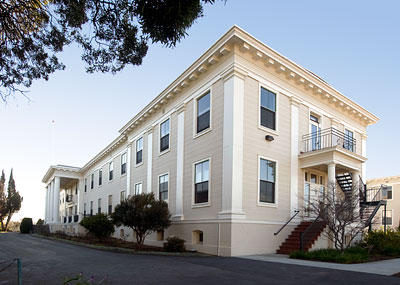National Register of Historic Places in Alameda County
Altenheim
1720 MacArthur Boulevard
Oakland
Built 1893
Rebuilt 1908
In 1869, the Central Pacific Railroad chose Oakland as the western terminus of the Transcontinental Railroad and transformed the East Bay into a popular destination. By 1900, Oakland's population was burgeoning with multi-ethnic communities.
The original Altenheim building was constructed within the Dimond District of Oakland in 1893 by the Altenheim Society, a group of Germanic immigrants dedicated to building an altenheim (old people's home) for their aging community members.
This building was destroyed by fire in 1908 and rebuilt within a year.
The Altenheim is historically significant because:
- it was the only elderly care institution in Oakland that catered to aging German Americans,
- rebuilt over the footprint of the 1893 building in 1908-09, is primarily intact and has been located on the same parcel since 1893,
- the Altenheim buildings have been surrounded by over two acres of open space or gardens for over 100 years,
- Altenheim maintained the same use for over a century, continuing to thrive and expand even after the inception of welfare programs and the Social Security Act of 1935
The Altenheim complex retains a high degree of integrity.
Adapted from the NRHP nomination.

The following is excerpted from an article in the 17 December 2010 edition of the San Francisco Chronicle:
Break out the beer and spaetzle - the Altenheim hums once more.
The 114-year-old German country retirement estate in the Oakland foothills officially reopened Thursday after lying vacant for nearly eight years. But now,
instead of wealthy older Germans, the elegant 6-acre compound will house low-income seniors of all nationalities....
The Altenheim was founded by San Francisco's most prominent German American families, the Sutros, Fleischhackers, Rosenbaums and others, as an
upscale home for older German speakers to live out their days.
The home resembles a grand Bavarian estate, with columns and porticos, high ceilings and rotundas. At the center is a sweeping, lodgelike
dining hall, adorned with original woodwork and hanging lights. The grounds include nearly 3 acres of gardens and views of San Francisco.
The Altenheim operated until 2002, when the Excelsior Center could no longer compete with cheaper senior homes nearby and was forced to close
the home for financial reasons. At that time, the number of German-speaking residents at the Altenheim had dropped to 35 percent, Willis said.
